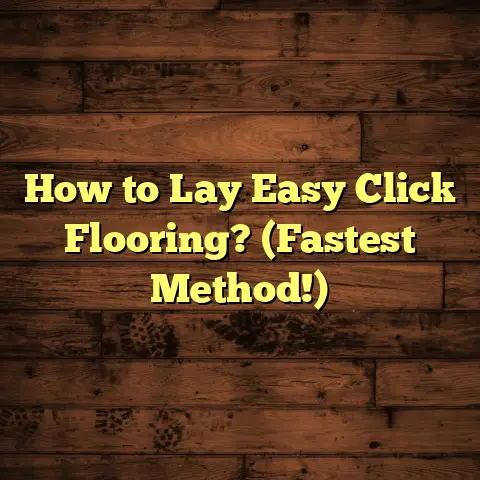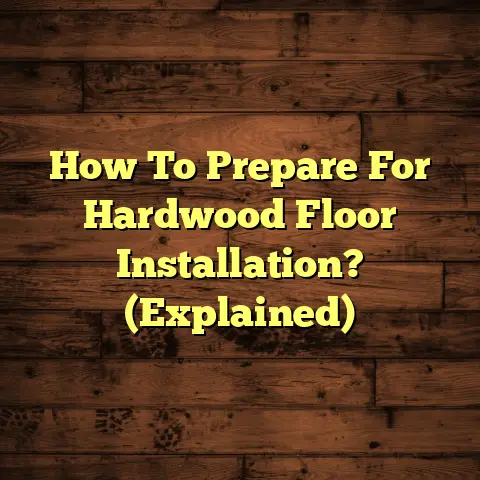Leftover Flooring? Don’t Trash It! (5 Upcycle Hacks!)
Let’s talk flooring.
I’ve been laying floors for over 20 years, and I’ve seen it all.
Think about your living room floor. It’s more than just a surface, right?
It’s the backdrop to countless memories.
I remember laying a beautiful oak floor for a family just before Christmas one year.
They told me how excited they were for the kids to open presents on it.
Flooring is where kids play, pets lounge, and friends gather.
It’s a canvas of our lives, holding stories within its grains and patterns.
So, what happens when the renovation is done and you’re left with extra planks or tiles?
The thought of tossing it all in the dumpster can be a real downer, I know.
It feels like throwing away a piece of those memories.
But what if I told you there was a better way?
A way to honor those memories and give those leftover materials a new life?
That’s where upcycling comes in!
Understanding the Value of Leftover Flooring
Over the years, I’ve worked with just about every type of flooring you can imagine.
We’re talking hardwood, laminate, vinyl, carpet remnants, tile – the whole nine yards.
And each one has its own potential for a second act.
Think about it: throwing away these materials isn’t just a waste of money; it’s also bad for the environment.
According to the EPA, in 2018, construction and demolition debris accounted for 600 million tons in the US alone.
That’s a staggering amount of waste ending up in landfills.
(Source: EPA Sustainable Management of Construction and Demolition Materials)
The good news is that there’s a growing trend towards sustainability in home renovation.
People are realizing the value of reducing waste and reusing materials.
And that’s where the magic happens!
Leftover flooring can be transformed into functional and beautiful items.
It just takes a little creativity and elbow grease.
I’ve seen some incredible projects over the years.
People turning scraps of hardwood into stunning coffee tables or using old tiles to create mosaic art.
The possibilities are endless.
The key is to see the potential in those leftover pieces.
To look beyond their original purpose and imagine what they could become.
It’s about turning waste into something wonderful.
Upcycle Hack #1 – Flooring Coasters
Alright, let’s get into our first upcycle hack: flooring coasters!
This is a super simple project that anyone can do, and it’s a great way to use up those smaller pieces of hardwood or laminate.
Here’s what you’ll need:
- Leftover hardwood or laminate flooring
- A saw (hand saw or power saw)
- Sandpaper (various grits)
- A ruler or measuring tape
- Pencil
- Wood stain or paint (optional)
- Protective sealant (polyurethane or varnish)
- Felt pads
Step 1: Measure and Cut
First, decide what size you want your coasters to be.
I usually go for around 4×4 inches, but you can adjust this to your liking.
Use your ruler and pencil to mark out the squares on your flooring.
Then, carefully cut along the lines with your saw.
Step 2: Sanding
Once you have your squares, it’s time to sand them down.
Start with a coarser grit sandpaper (like 80 or 100) to smooth out any rough edges.
Then, move on to a finer grit (like 220) to create a smooth surface.
This is important for both aesthetics and comfort.
You don’t want anyone snagging their fingers on a rough coaster!
Step 3: Finishing (Optional)
This step is all about personalization.
If you want to add some color to your coasters, now’s the time to stain or paint them.
You can go for a classic wood stain to enhance the natural grain of the wood.
Or you can get creative with paint and add some fun designs.
Step 4: Protective Sealant
Once your stain or paint is dry, it’s time to apply a protective sealant.
This will help to protect the wood from water rings and spills.
I recommend using a polyurethane or varnish.
Apply a thin coat and let it dry completely before applying another coat.
Step 5: Add Felt Pads
Finally, add felt pads to the bottom of your coasters.
This will prevent them from scratching your furniture.
You can find these at most hardware stores.
And there you have it!
Beautiful, handmade coasters from leftover flooring.
I made a set of these for my sister last year, and she absolutely loved them.
She said they added a rustic charm to her living room.
And the best part is that they’re functional too!
Upcycle Hack #2 – Wall Art and Decor
Ready for something a little more ambitious?
Let’s talk wall art and decor.
Leftover flooring can be transformed into some truly stunning pieces that will add character to any room.
Here are a few ideas to get you started:
Mosaic Art: Cut your flooring into small pieces and arrange them into a mosaic pattern.
You can create anything from abstract designs to intricate landscapes.Framed Flooring: Choose a particularly beautiful piece of flooring and frame it like a piece of art.
This works especially well with hardwood that has a unique grain pattern.Rustic Signs: Use flooring to create rustic signs with quotes, sayings, or family names.
This is a great way to add a personal touch to your home.
Let’s do a wall-mounted key holder.
Here’s what you’ll need:
- Leftover flooring (hardwood, laminate, or vinyl)
- A saw
- Sandpaper
- Wood stain or paint (optional)
- Hooks
- Screws
- Drill
- Picture hanging hardware
Step 1: Cut and Sand
Cut a piece of flooring to your desired size for the key holder.
I recommend something around 12-18 inches long.
Sand the edges and surface to create a smooth finish.
Step 2: Finishing (Optional)
Stain or paint the flooring to match your decor.
Let it dry completely.
Step 3: Attach Hooks
Decide where you want to place your hooks.
Mark the spots with a pencil and then use a drill to create pilot holes.
This will make it easier to screw in the hooks.
Attach the hooks using screws.
Step 4: Add Hanging Hardware
Attach picture hanging hardware to the back of the key holder.
Make sure it’s strong enough to support the weight of the wood and the keys.
Step 5: Hang and Enjoy
Hang your new key holder near your door and enjoy!
I made something similar for my entryway a few years ago, and it’s been a lifesaver.
No more searching for keys in the morning!
Upcycle Hack #3 – Furniture Revamp
Now, let’s move on to something a little more involved: furniture revamping.
This is where you can really get creative and transform old, tired furniture into something new and exciting.
One of my favorite ways to use leftover flooring is to create a new tabletop for a coffee table.
Here’s how you can do it:
- Leftover flooring (enough to cover the tabletop)
- A saw
- Sandpaper
- Wood glue
- Clamps
- Measuring tape
- Pencil
- Finishing nails (optional)
- Wood filler (optional)
- Wood stain or paint (optional)
- Protective sealant
Step 1: Measure and Cut
Measure the dimensions of your existing tabletop.
Then, cut your flooring planks to the appropriate length.
You may need to cut multiple planks to fit the width of the tabletop.
Step 2: Prepare the Surface
Sand the existing tabletop to create a smooth surface.
This will help the wood glue adhere properly.
Step 3: Glue and Clamp
Apply wood glue to the back of the flooring planks and carefully place them onto the tabletop.
Use clamps to hold the planks in place while the glue dries.
This is important to ensure a strong bond.
Step 4: Add Finishing Nails (Optional)
For extra security, you can add finishing nails along the edges of the planks.
Be sure to countersink the nails so they don’t stick out.
Step 5: Fill Gaps (Optional)
If there are any gaps between the planks, you can fill them with wood filler.
Let the wood filler dry completely and then sand it smooth.
Step 6: Finishing
Stain or paint the new tabletop to match your decor.
Apply a protective sealant to protect the wood from scratches and spills.
I helped a friend revamp an old coffee table using this method last year.
She had some leftover laminate flooring from her kitchen renovation.
We used it to create a new tabletop for her coffee table, and it looked amazing!
It completely transformed the look of her living room.
She was so proud of what we had accomplished together.
Upcycle Hack #4 – Planters and Garden Items
Let’s take things outside!
Leftover flooring can also be used to create planters and garden decor.
This is a great way to add a personal touch to your outdoor spaces while promoting sustainability.
One popular option is to build raised garden beds using leftover wood.
However, for this guide, we are going to make a simple wooden planter box.
Here’s what you’ll need:
- Leftover flooring (enough for the sides and bottom of the planter box)
- A saw
- Sandpaper
- Wood glue
- Screws
- Drill
- Measuring tape
- Pencil
- Potting soil
- Plants
Step 1: Measure and Cut
Decide on the size of your planter box.
Then, cut the flooring planks to the appropriate length for the sides and bottom of the box.
Step 2: Assemble the Box
Apply wood glue to the edges of the planks and assemble the box.
Use screws to hold the planks together.
Step 3: Sand and Finish
Sand the edges and surface of the planter box to create a smooth finish.
You can also paint or stain the box to match your outdoor decor.
Step 4: Add Potting Soil and Plants
Fill the planter box with potting soil and add your favorite plants.
I made a few of these planter boxes for my patio last spring.
I used some leftover cedar planks that I had from a deck project.
They looked great filled with colorful flowers.
It really brightened up the space.
Upcycle Hack #5 – Pet Projects
Last but not least, let’s talk about projects for our furry friends.
Leftover flooring can be transformed into pet beds, feeding stations, or even toys.
My personal favorite is making a stylish pet bed using flooring.
Here’s how you can do it:
- Leftover flooring (enough for the base and sides of the pet bed)
- A saw
- Sandpaper
- Wood glue
- Screws
- Drill
- Measuring tape
- Pencil
- Soft fabric or padding
- Sewing machine (optional)
Step 1: Measure and Cut
Decide on the size of your pet bed.
Then, cut the flooring planks to the appropriate length for the base and sides of the bed.
Step 2: Assemble the Bed
Apply wood glue to the edges of the planks and assemble the bed.
Use screws to hold the planks together.
Step 3: Sand and Finish
Sand the edges and surface of the pet bed to create a smooth finish.
You can also paint or stain the bed to match your decor.
Step 4: Add Padding
Cut a piece of soft fabric or padding to fit inside the pet bed.
You can sew a simple cover for the padding if you want to make it washable.
Step 5: Place Padding in Bed
Place the padding inside the pet bed and let your furry friend enjoy their new cozy space.
I made one of these pet beds for my dog, Max, a few years ago.
He absolutely loved it!
He would spend hours lounging in his new bed.
It was so rewarding to see him enjoying something that I had created from leftover materials.
Conclusion
So, there you have it!
Five awesome upcycle hacks for your leftover flooring.
I hope this article has inspired you to look at those leftover pieces in a new light.
They’re not just waste; they’re a blank canvas waiting to be transformed into something beautiful and functional.
Remember, upcycling is not just about reducing waste; it’s also about creating something meaningful.
It’s about turning memories into tangible objects that you can enjoy for years to come.
It’s about adding a personal touch to your home and making it truly your own.
So, go ahead, embrace your leftover flooring and start creating!
I can’t wait to see what you come up with.
Happy upcycling!





